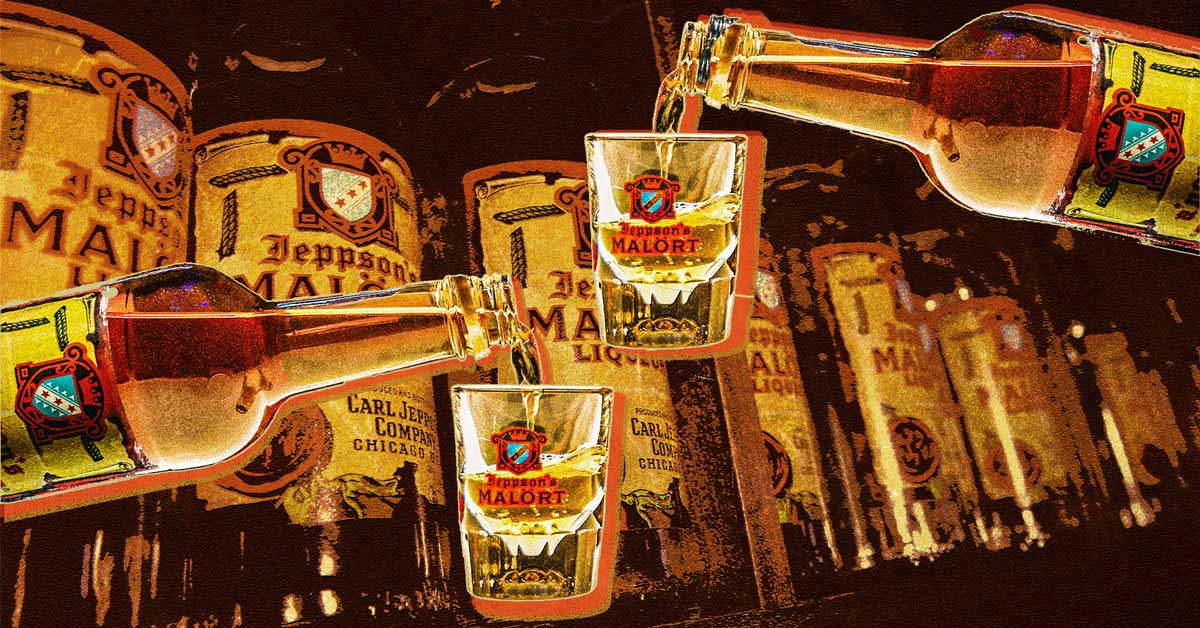In the last few years, it seems, Malört has gone from a little-known liqueur to national sensation. The Chicago product was served as the unofficial drink of the 2024 Democratic National Convention; it’s been celebrated at festivals, and an entire book has even been written about it.
But has this been the same Malört the whole time? Fans of the notorious dare shot are questioning whether the liqueur is as bitter (and even as “gross”) as it once was.
“Has anyone noticed a change in the flavor of Malort since production moved to Chicago?” wrote a Redditor in the r/Chicago subreddit three years ago. “I feel like the Chicago production is less offensive, whereas the vintage Florida product is the swill we know and love.”
Jeppson’s Malört was originally produced in Chicago, from immediately after Prohibition until 1986 when the Mar-Salle Distillery closed. It was then made in Kentucky for a short time before moving in 1989 to Florida, where it gained its nasty reputation—akin to “taking a bite out of a grapefruit and then drinking a shot of gasoline,” according to Tremaine Atkinson.
In 2018, Atkinson’s Chicago-based CH Distillery acquired Malört and by the next year had again begun to produce it in its birthplace. Suddenly, Malört lovers weren’t tasting things they had tasted before.
“A certain X factor was lost in translation. Possibly body? Maybe a 10 percent dip in tertiary citrus?” says Corban Kell, the general manager and beverage director at Billy Sunday in Chicago. “The thing I’ll say for sure is the old stuff didn’t stop till you made it stop and the newer batches I’ve enjoyed definitely abate after a minute on their own,” he says, citing the long, extremely bitter finish in previous iterations of the liqueur. After production moved to Chicago, at least one local bar was known to charge more for its holdover stash of Florida-made Malört.
Speculation continues to abound online. Has Chicago’s water made it more palatable? Or could CH’s removal of artificial coloring have had an effect? Maybe it was just getting to Chicago bars in a fresher state than ever before? There has even been conjecture that the prevalence of meth in Polk County, Florida, was what was causing the odd hairspray-meets-grapefruit flavor.
But not everyone agrees, and that was true right from the get-go. “[F]or better or worse, it maintains the essence of grapefruit meets gasoline,” wrote the Chicago Tribune’s Louisa Kung Liu Chu upon tasting the new Chicago iteration in 2019.
Bartender Charles Joly had his first shot of Malört sometime in the late 1990s at the original Holiday Club in Chicago’s Wicker Park neighborhood. He too dismisses the online chatter, hypothesizing that drinkers’ palates have merely matured over the last few decades, with the rising popularity of amari and other bitter liqueurs now on the market.
“I don’t think that the current Malört is less bitter than the old bottles,” says Joly. Today, he continues to serve Malört as part of the The Bukowski Cocktail at New York’s Riff Raff Club. “I will say this, the old Malört was wildly inconsistent from batch to batch and was probably using the cheapest [grain neutral spirit] available to infuse.”
For what it’s worth, Atkinson agrees that Chicago-made Malört tastes a bit different—because, in a way, it’s meant to. CH Distillery is now using organic rye and wheat from nearby Kane County to make its distillate, while sourcing wormwood, the principal flavor ingredient, from all over the world, including Skåne, Sweden, where the original Malört creator, Carl Jeppson, was raised.
“Like any natural crop, wormwood’s flavor varies from regional climate, season and soil variances,” says Atkinson. “If all of this makes Malört taste ‘better,’ we’re not sorry!”











